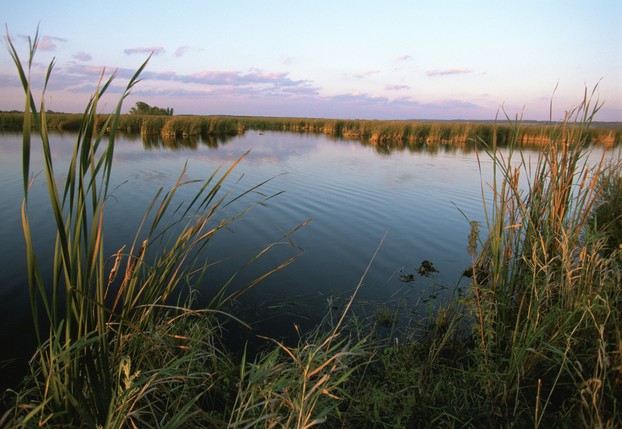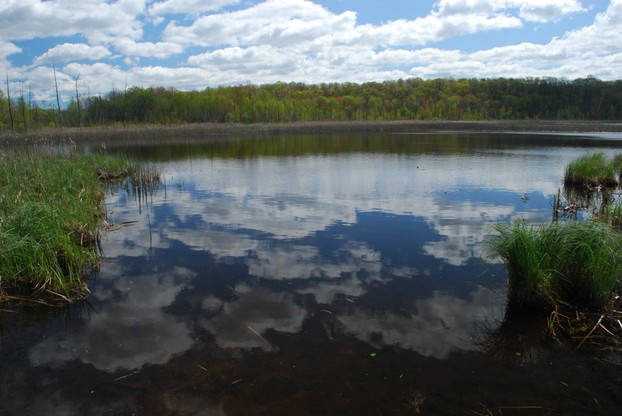Henry S Reuss Ice Age Visitor Center near Dundee: headquarters of northern unit of Kettle Moraine State Forest: Royalbroil, CC BY-SA 2.5, via Wikimedia Commons @ https://en.wikipedia.org/wiki/File:ReussIceAgeVisitorCenter.jpg
Note winter pack ice's extension further south than now: Hannes Grobe-Alfred Wegener Institute Polar/Marine Research-Bremerhaven, CC BY-SA 2.5, via Wikimedia Commons @ https://commons.wikimedia.org/wiki/File:Northern_icesheet-fr.png
designated as Ramsar Site #511 on 4/12/90 for importance for nesting and international spring/fall flyway: Ryan Hagerty/US Fish and Wildlife Service, Public Domain, via USFWS Digital Library @ https://digitalmedia.fws.gov/digital/collection/natdiglib/id/8993
Chippewa Moraine State Recreation Area: The Cut, CC BY 2.0, via Flickr @ https://www.flickr.com/photos/63875512@N04/6612597909/
Devil's Lake and its soaring bluffs: Robin Davies (newlow), CC BY 2.0, via Flickr @ https://www.flickr.com/photos/newlow/2942736580/
7 Hills Road, Mount Calvary, east central Wisconsin, north of Henry S Reuss Ice Age Visitor Center: Royal Broil (royal_broil), CC BY-SA 2.0, via Flickr @ https://www.flickr.com/photos/royal_broil/2578823275/
kame's distinctive conical shape: Wisconsin Department of Natural Resources, CC BY ND 2.0, via Flickr @ http://www.flickr.com/photos/widnr/6587805463/
glacial kame hovering behind cornfield: Royal Broil (royal_broil), C BY-SA 2.0, via Flickr @ http://www.flickr.com/photos/royal_broil/8265044337/
a kettle, or pothole, lake in Eagle Oak Opening State Natural Area (No.66), Waukesha County, Kettle Moraine State Forest-Southern Unit: Joshua Mayer (wackybadger), CC BY SA 2.0, via Flickr @ http://www.flickr.com/photos/wackybadger/4580685854/
bouldered moraine along Ice Age National Scenic Trail, Devil's Lake: Wisconsin Dept of Natural Resources, CC BY-ND 2.0, via Flickr @ http://www.flickr.com/photos/widnr/6550537591/.
view from Lapham Peak Unit Lookout Tower: Wisconsin Dept Natural Resources, CC BY-ND 2.0, via Flickr @ http://www.flickr.com/photos/widnr/6582429393/
Spruce Lake Bog State Natural Area: Wisconsin Dept of Natural Resources, CC BY-ND 2.0, via Flickr @ http://www.flickr.com/photos/widnr/6583098929/
Pike Lake: Michael Pereckas (Beige Alert), CC BY 2.0, via Flickr @ https://www.flickr.com/photos/beigephotos/6067301819/
Old World Wisconsin, a popular historic attraction in Kettle Moraine State Forest's Southern Unit: Randen Pederson (chefranden), CC BY 2.0, via Wikimedia Commons @ https://commons.wikimedia.org/wiki/File:OldWorldWisconsinRaspberrySchoolHouse.jpg; originally via Flickr @ http://www.flickr.com/photos/48394718@N00/272791990
Oak Opening State Natural Area (No. 229), Kettle Moraine State Forest-Southern Unit: Wisconsin Department of Natural Resources, Public Domain, via NPS Ice Age National Scenic Trail @ http://www.nps.gov/media/photo/gallery.htm?id=696BF7AA-155D-4519-3EDAA2ADA723FC33
Congressman Henry S. Reuss wrote about trailing the ice age: US House of Representatives, Public Domain, via Wikimedia Commons @ http://en.wikipedia.org/wiki/File:Henry_S._Reuss.jpg
Dalles of the St. Croix River, Interstate State Park: 123dieinafire, Public Domain, via Wikimedia Commons @ https://en.wikipedia.org/wiki/File:Dalles_Of_St_Croix.jpg
Parnell Observation Tower: Royalbroil, CC BY-SA 2.5, via Wikimedia Commons @ https://en.wikipedia.org/wiki/File:ParnellTower2007.jpg
spectacular bird's eye views from Parnell Tower: Aaron Cantleberry, CC BY ND 2.0, via Flickr @ http://www.flickr.com/photos/aaroncantleberry/5766762920/
Kettle Moraine Scenic Drive, LaGrange, Walworth County, southeastern Wisconsin: Wisconsin Dept of Natural Resources, CC BY-ND 2.0, via Flickr @ http://www.flickr.com/photos/widnr/6582434171/
1838 oil on canvas by George Catlin (July 26, 1796-December 23, 1872): Smithsonian American Art Museum, Public Domain, via Wikimedia Commons @ https://en.wikipedia.org/wiki/File:Osceola.jpg
stand of paper birch (Betula papyreus), Milwaukee River Tamarack Lowlands and Dundee Kame State Natural Area (no. 256): Joshua Mayer (wackybadger), CC BY SA 2.0, via Flickr @ https://www.flickr.com/photos/wackybadger/4596896443/
kame in Kettle Moraine State Forest: Abloe428, Public Domain, via Wikibooks @ https://en.wikibooks.org/wiki/File:Kame.jpg
Butler Lake and Flynn's Spring State Natural Area (No. 257), Kettle Moraine State Forest Northern Unit: Joshua Mayer (wackybadger), CC BY-SA 2.0, via Flickr @ https://www.flickr.com/photos/wackybadger/5563306568/
































 Are Hawaiian Huakai Po Nightmarchers Avenging Halloween Thursday?on 10/02/2024
Are Hawaiian Huakai Po Nightmarchers Avenging Halloween Thursday?on 10/02/2024
 Mailing Addresses for 2023 Form 4868 Extending 1040 and 1040SR April 15, 2024, Due Dateon 04/15/2024
Mailing Addresses for 2023 Form 4868 Extending 1040 and 1040SR April 15, 2024, Due Dateon 04/15/2024
 Mailing Addresses for 2023 Forms 1040 and 1040SR Filed in 2024on 04/15/2024
Mailing Addresses for 2023 Forms 1040 and 1040SR Filed in 2024on 04/15/2024
 Mailing Addresses for 2022 Form 4868 Extending 1040 and 1040SR April 18, 2023, Due Dateon 04/13/2023
Mailing Addresses for 2022 Form 4868 Extending 1040 and 1040SR April 18, 2023, Due Dateon 04/13/2023



Comments